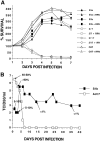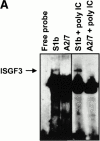The serine proteinase inhibitor (serpin) plasminogen activation inhibitor type 2 protects against viral cytopathic effects by constitutive interferon alpha/beta priming
- PMID: 9607921
- PMCID: PMC2212304
- DOI: 10.1084/jem.187.11.1799
The serine proteinase inhibitor (serpin) plasminogen activation inhibitor type 2 protects against viral cytopathic effects by constitutive interferon alpha/beta priming
Abstract
The serine proteinase inhibitor (serpin) plasminogen activator inhibitor type 2 (PAI-2) is well characterized as an inhibitor of extracellular urokinase-type plasminogen activator. Here we show that intracellular, but not extracellular, PAI-2 protected cells from the rapid cytopathic effects of alphavirus infection. This protection did not appear to be related to an effect on apoptosis but was associated with a PAI-2-mediated induction of constitutive low-level interferon (IFN)-alpha/beta production and IFN-stimulated gene factor 3 (ISGF3) activation, which primed the cells for rapid induction of antiviral genes. This primed phenotype was associated with a rapid development of resistance to infection by the PAI-2 transfected cells and the establishment of a persistent productive infection. PAI-2 was also induced in macrophages in response to viral RNA suggesting that PAI-2 is a virus response gene. These observations, together with the recently demonstrated PAI-2-mediated inhibition of tumor necrosis factor-alpha induced apoptosis, (a) illustrate that PAI-2 has an additional and distinct function as an intracellular regulator of signal transduction pathway(s) and (b) demonstrate a novel activity for a eukaryotic serpin.
Figures













Similar articles
-
The C-D interhelical domain of the serpin plasminogen activator inhibitor-type 2 is required for protection from TNF-alpha induced apoptosis.Cell Death Differ. 1998 Feb;5(2):163-71. doi: 10.1038/sj.cdd.4400324. Cell Death Differ. 1998. PMID: 10200461
-
Plasminogen activator inhibitor type 2 inhibits tumor necrosis factor alpha-induced apoptosis. Evidence for an alternate biological function.J Biol Chem. 1995 Nov 17;270(46):27894-904. doi: 10.1074/jbc.270.46.27894. J Biol Chem. 1995. PMID: 7499264
-
The undecided serpin. The ins and outs of plasminogen activator inhibitor type 2.FEBS J. 2005 Oct;272(19):4858-67. doi: 10.1111/j.1742-4658.2005.04879.x. FEBS J. 2005. PMID: 16176260 Review.
-
Evidence for serpinB2-independent protection from TNF-alpha-induced apoptosis.Exp Cell Res. 2006 Feb 1;312(3):350-61. doi: 10.1016/j.yexcr.2005.11.003. Epub 2005 Dec 5. Exp Cell Res. 2006. PMID: 16330024
-
Interferons alpha and beta as immune regulators--a new look.Immunity. 2001 Jun;14(6):661-4. doi: 10.1016/s1074-7613(01)00154-6. Immunity. 2001. PMID: 11420036 Review. No abstract available.
Cited by
-
Chikungunya virus arthritis in adult wild-type mice.J Virol. 2010 Aug;84(16):8021-32. doi: 10.1128/JVI.02603-09. Epub 2010 Jun 2. J Virol. 2010. PMID: 20519386 Free PMC article.
-
Biology and pathogenesis of chikungunya virus.Nat Rev Microbiol. 2010 Jul;8(7):491-500. doi: 10.1038/nrmicro2368. Nat Rev Microbiol. 2010. PMID: 20551973 Review.
-
Host Derivation of Sindbis Virus Influences Mammalian Type I Interferon Response to Infection.Viruses. 2023 Aug 3;15(8):1685. doi: 10.3390/v15081685. Viruses. 2023. PMID: 37632027 Free PMC article.
-
Characterisation of PAUSE-1, a powerful silencer in the human plasminogen activator inhibitor type 2 gene promoter.Nucleic Acids Res. 2001 Oct 1;29(19):3919-27. doi: 10.1093/nar/29.19.3919. Nucleic Acids Res. 2001. PMID: 11574673 Free PMC article.
-
Serpins in Venous Thrombosis and Venous Thrombus Resolution.Methods Mol Biol. 2018;1826:197-211. doi: 10.1007/978-1-4939-8645-3_13. Methods Mol Biol. 2018. PMID: 30194602 Free PMC article.
References
-
- Remold-O'Donnell E. The ovalbumin family of serpin proteins. FEBS Lett. 1993;315:105–108. - PubMed
-
- Ray CA, Black RA, Kronheim SR, Greenstreet TA, Sleath PR, Salvesen GS, Pickup DJ. Viral inhibition of inflammation: cowpox virus encodes an inhibitor of the interleukin-1β converting enzyme. Cell. 1992;69:597–604. - PubMed
-
- Zou Z, Anisowicz A, Hendrix MJC, Thor A, Neveu M, Sheng S, Rafidi K, Seftor E, Sager R. Maspin, a serpin with tumor-suppressing activity in human mammary epithelial cells. Science. 1994;263:526–529. - PubMed
-
- Scott FL, Coughlin PB, Bird C, Cerruti L, Hayman JA, Bird P. Protease inhibitor 6 cannot be secreted, which suggests it's a new type of cellular serpin. J Biol Chem. 1996;271:1605–1612. - PubMed
Publication types
MeSH terms
Substances
LinkOut - more resources
Full Text Sources
Other Literature Sources

